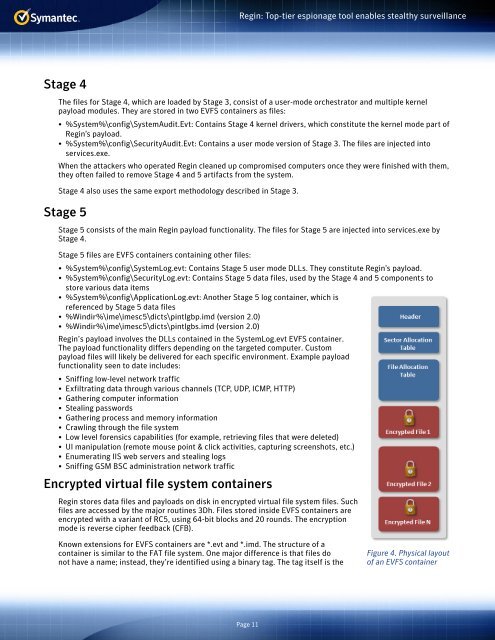You also want an ePaper? Increase the reach of your titles
YUMPU automatically turns print PDFs into web optimized ePapers that Google loves.
Regin: Top-tier espionage tool enables stealthy surveillance<br />
Stage 4<br />
The files for Stage 4, which are loaded by Stage 3, consist of a user-mode orchestrator and multiple kernel<br />
payload modules. They are stored in two EVFS containers as files:<br />
• %System%\config\SystemAudit.Evt: Contains Stage 4 kernel drivers, which constitute the kernel mode part of<br />
Regin’s payload.<br />
• %System%\config\SecurityAudit.Evt: Contains a user mode version of Stage 3. The files are injected into<br />
services.exe.<br />
When the attackers who operated Regin cleaned up compromised computers once they were finished with them,<br />
they often failed to remove Stage 4 and 5 artifacts from the system.<br />
Stage 4 also uses the same export methodology described in Stage 3.<br />
Stage 5<br />
Stage 5 consists of the main Regin payload functionality. The files for Stage 5 are injected into services.exe by<br />
Stage 4.<br />
Stage 5 files are EVFS containers containing other files:<br />
• %System%\config\SystemLog.evt: Contains Stage 5 user mode DLLs. They constitute Regin’s payload.<br />
• %System%\config\SecurityLog.evt: Contains Stage 5 data files, used by the Stage 4 and 5 components to<br />
store various data items<br />
• %System%\config\ApplicationLog.evt: Another Stage 5 log container, which is<br />
referenced by Stage 5 data files<br />
• %Windir%\ime\imesc5\dicts\pintlgbp.imd (version 2.0)<br />
• %Windir%\ime\imesc5\dicts\pintlgbs.imd (version 2.0)<br />
Regin’s payload involves the DLLs contained in the SystemLog.evt EVFS container.<br />
The payload functionality differs depending on the targeted computer. Custom<br />
payload files will likely be delivered for each specific environment. Example payload<br />
functionality seen to date includes:<br />
• Sniffing low-level network traffic<br />
• Exfiltrating data through various channels (TCP, UDP, ICMP, HTTP)<br />
• Gathering computer information<br />
• Stealing passwords<br />
• Gathering process and memory information<br />
• Crawling through the file system<br />
• Low level forensics capabilities (for example, retrieving files that were deleted)<br />
• UI manipulation (remote mouse point & click activities, capturing screenshots, etc.)<br />
• Enumerating IIS web servers and stealing logs<br />
• Sniffing GSM BSC administration network traffic<br />
Encrypted virtual file system containers<br />
Regin stores data files and payloads on disk in encrypted virtual file system files. Such<br />
files are accessed by the major routines 3Dh. Files stored inside EVFS containers are<br />
encrypted with a variant of RC5, using 64-bit blocks and 20 rounds. The encryption<br />
mode is reverse cipher feedback (CFB).<br />
Known extensions for EVFS containers are *.evt and *.imd. The structure of a<br />
container is similar to the FAT file system. One major difference is that files do<br />
not have a name; instead, they’re identified using a binary tag. The tag itself is the<br />
Figure 4. Physical layout<br />
of an EVFS container<br />
Page 11


